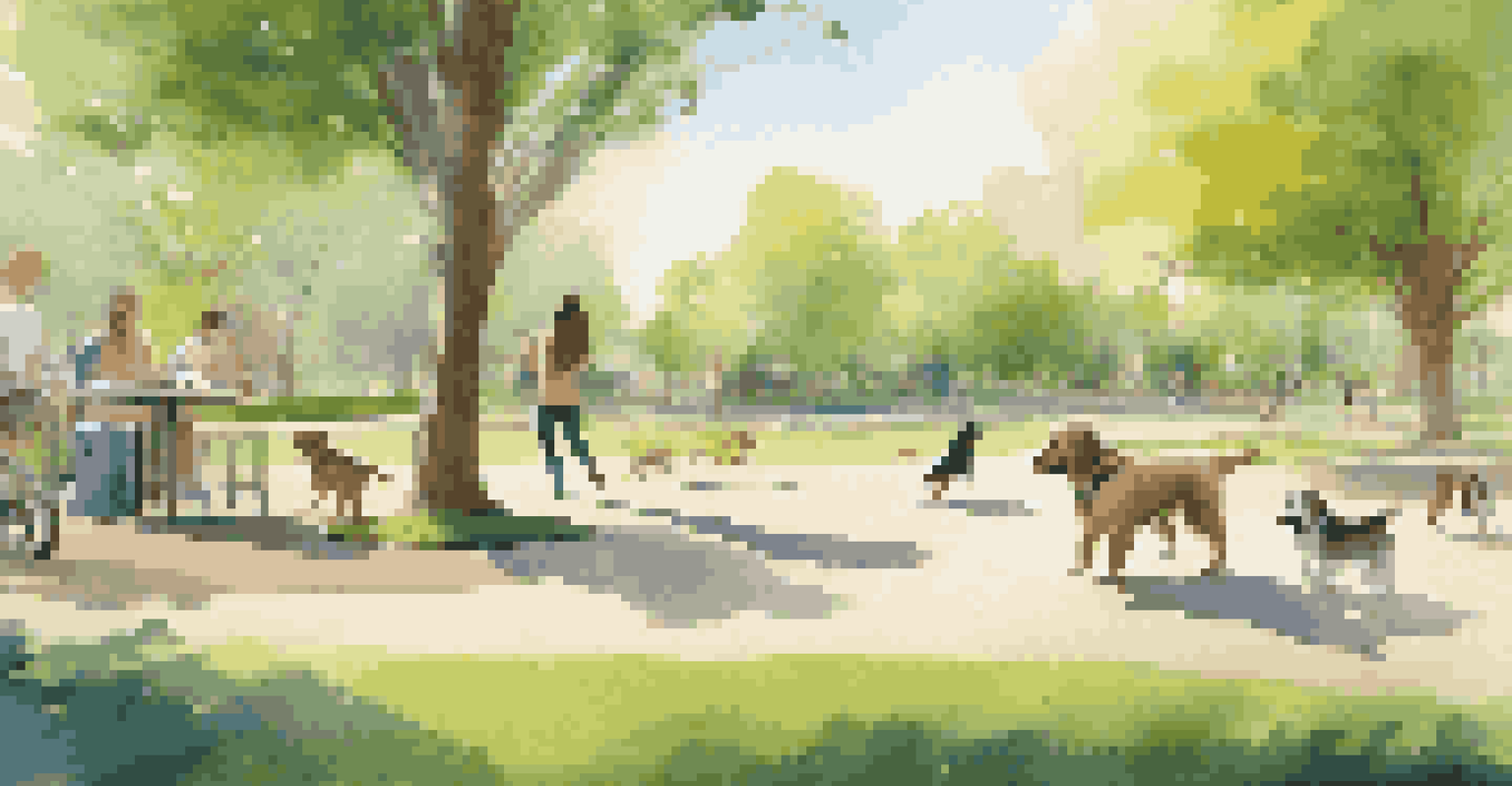Augmented Reality for Pet Training: Interactive Learning

Understanding Augmented Reality in Pet Training
Augmented Reality (AR) refers to the technology that superimposes digital information onto the real world. In the context of pet training, AR creates an interactive environment that can enhance learning experiences for both pets and their owners. Imagine being able to see training commands visually represented right in your living room, guiding your pet's behavior in real-time.
Technology is best when it brings people together.
This innovative approach allows trainers to use AR applications that provide visual cues and demonstrations, making the learning process more engaging. For instance, when teaching a dog to sit, an AR overlay can show an animated dog sitting down, which can help your pet understand the command faster. By bridging the gap between physical and digital, AR offers a fresh perspective on traditional training methods.
As AR technology continues to evolve, it becomes increasingly user-friendly and accessible. Pet owners no longer need to rely solely on verbal commands or physical demonstrations; they can now leverage technology to create a more interactive and effective training session. This shift not only benefits the pets but also empowers owners with new tools to enhance their training strategies.
Benefits of Interactive Learning for Pets
Interactive learning through AR provides numerous benefits for pets, particularly when it comes to engagement and motivation. Pets, much like humans, respond better to visual and interactive stimuli. By using AR, training becomes a game, capturing their attention and making the learning process fun rather than a chore.

For example, an AR app might reward your pet with virtual treats or praise when they successfully perform a command. This instant feedback creates a positive reinforcement loop, encouraging pets to repeat desired behaviors. The gamification of training can lead to quicker learning and a stronger bond between the pet and owner.
AR Enhances Pet Training Engagement
Augmented Reality transforms pet training into an interactive experience, making learning fun and engaging for both pets and their owners.
Moreover, interactive learning allows for personalized experiences tailored to individual pet needs. Different breeds and personalities may require unique training approaches. With AR, owners can adapt their training methods and visuals to better suit their pet's learning style, making each session more productive and enjoyable.
How AR Can Enhance Common Training Commands
When it comes to training common commands like 'sit,' 'stay,' or 'come,' AR can provide visual aids that make understanding easier for pets. For example, an AR application could project a virtual dog that demonstrates the 'sit' command, helping your pet visualize what is expected. This method can significantly improve comprehension, especially for younger or more playful pets.
The greatest gift you can give your pet is your time.
Additionally, AR can help with more complex commands by breaking them down into smaller, manageable steps. Each step can be visually represented, allowing the pet to focus on one aspect at a time. This gradual approach not only aids in learning but also builds confidence as the pet successfully masters each stage.
Furthermore, AR can also simulate real-life distractions, helping pets learn to focus in various environments. By incorporating scenarios where other animals or noises are present, pets can practice commands in a controlled yet challenging setting, preparing them for real-world situations.
Creating a Customized Training Experience
One of the standout features of AR is its ability to create customized training experiences. Each pet is unique, with different temperaments and learning speeds, and AR allows owners to tailor their training sessions accordingly. For instance, an AR app could adjust the difficulty level based on the pet's progress, ensuring that the training remains challenging yet achievable.
Moreover, pet owners can select specific training goals, whether it's basic obedience, tricks, or socialization skills. The AR technology can then provide targeted exercises and demonstrations, streamlining the learning process. This personalization keeps pets engaged and motivated, as they can see their progress and work towards tangible goals.
Personalized Training with AR
AR allows for customized training sessions tailored to a pet's unique needs, enhancing their learning experience and motivation.
As a result, the bond between pet and owner is strengthened through these shared experiences. When training sessions are enjoyable and effective, both parties are more likely to participate and invest time in the process, leading to a happier and better-behaved pet.
The Role of Gamification in Pet Training
Gamification refers to the use of game-like elements in non-game contexts to enhance engagement and motivation. In the realm of pet training, AR incorporates gamification by rewarding pets with points, badges, or virtual rewards for completing tasks or mastering commands. This element of play transforms mundane training sessions into exciting challenges for pets.
For example, an AR app might incorporate quizzes or obstacle courses that pets can navigate while learning new commands. By competing against the clock or their own best scores, pets become more invested in their training. This playful approach not only motivates pets but also encourages them to repeat desired behaviors more frequently.
Additionally, gamification can create a shared experience between pets and their owners. Engaging in challenges together fosters teamwork and strengthens the bond, making training a more fulfilling experience for both. Over time, this can lead to improved behavior and a deeper understanding of commands, benefiting the overall relationship.
Integrating AR with Traditional Training Techniques
While AR offers exciting new possibilities, it's important to remember that it works best when integrated with traditional training methods. Combining technology with established techniques can create a well-rounded approach to pet training. For instance, using AR to supplement verbal commands can reinforce learning and enhance understanding.
By incorporating elements like positive reinforcement, consistency, and patience, pet owners can create a balanced training regimen. AR can provide visual support while owners remain the primary source of guidance and encouragement. This blend of approaches ensures that pets receive comprehensive training that caters to both their emotional and cognitive needs.
Gamification Boosts Training Motivation
Incorporating gamification elements into AR applications makes training more enjoyable, encouraging pets to participate actively and repeat desired behaviors.
Moreover, integrating AR with traditional techniques allows for flexibility in training. Owners can choose to rely on AR when needed or revert to hands-on training methods based on their pet's responsiveness. This adaptability not only benefits the pet but also empowers the owner to become a more effective trainer.
The Future of AR in Pet Training
As technology continues to advance, the future of AR in pet training looks promising. Developers are constantly working to enhance the capabilities of AR applications, making them more user-friendly and effective. We can expect to see even more interactive features, such as virtual trainers or advanced analytics that track a pet's progress over time.
In the coming years, AR could also incorporate artificial intelligence (AI) to provide personalized training recommendations based on a pet's behavior patterns. Imagine an app that learns your pet's strengths and weaknesses, adapting its training strategies accordingly. This level of customization could revolutionize how we approach pet training.

Ultimately, the goal of integrating AR into pet training is to create a more enjoyable and productive experience. As pet owners embrace these innovative tools, they can look forward to a future where training is not only effective but also fun, fostering stronger connections between pets and their humans.